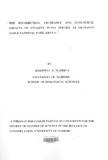| dc.description.abstract | Invasive species are a major conservation and management concerns in natural
ecosystems and pose a significant threat to many of Africa's conservation areas. The
aim of this study was to asses the impacts of invasive plants species on the biodiversity
of Ol-Donyo Sabuk National Park. The objectives were to determine the types and
distribution of vegetation at the National Park, assess the types, distribution and
abundance of invasive plant species, determine the birds and mammal species associated
with invasive plant species and examine the factors that were related to the dispersal of
invasive plants species. The study area was stratified by analysing an advanced spaceborne
thermal emission and reflection radiometer (ASTER) imagery and line transect
method was used to describe the vegetation in the different strata. Invasive species
impact on biodiversity was quantified through random quadrant sampling method while
factors related to the dispersal and spread of invasive plant species were determined
through point-count and line transects methods. Data was analysed through calculation
of density for the different species and Shannon-wiener diversity (HI) and evenness (JI)
indices for each stratum. Student t test was used to compare diversity differences
between the invaded and un-invaded sites. Chi-square (X2) test was used to test for
trophic differences in mammals and birds associated with disturbed and invaded areas
between the wet and dry seasons. Analysis of variance (ANOVA) tests to determine
species associations between the different sampling strata within the study and
surrounding areas. Results from imagery analysis revealed seven land-cover types with
closed canopy forests being the largest and dams the least. Lantana camara L. was the
most abundant invader species and invaded areas had lower species diversity but higher
plant density. There was significant difference in species diversity between invaded and
un-invaded sites (t =2.41, P< 0.05). In the surrounding areas, invasive species were
equally distributed (F=0.0065, P<0.05). There was significant difference in the trophic
status for birds associated with disturbed and invaded areas between the sampling
seasons with higher number of insectivore/gramnivores in dry season and higher number
of nectivores in the wet season. (X2= 83.338, P<0.001, d.f =6). Diversity and density
also differed with type of disturbances being highest in places with edge effect.
Mammals didn't differ significantly between the dry and wet seasons (X2=16.656, P <
0.005, d.f=S). Edge effects were strongly associated with occurrence of invasive species.
The study showed that invasive species had negative impact on native species diversity. | en |

